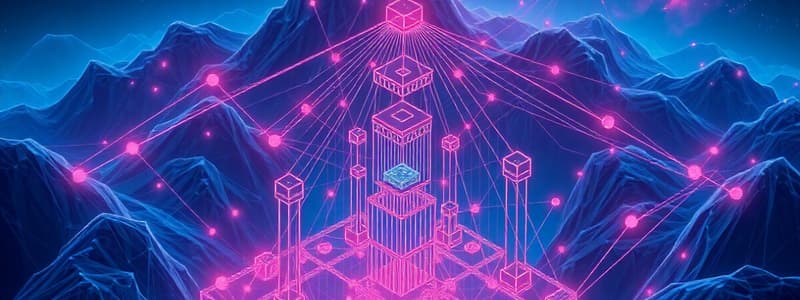Podcast
Questions and Answers
What is the structure of the hierarchical database model?
What is the structure of the hierarchical database model?
- Graph-like structure
- Flat structure
- Tree-like structure (correct)
- Circular structure
Which of the following statements is true about child nodes in the hierarchical model?
Which of the following statements is true about child nodes in the hierarchical model?
- Child nodes are not used in this model.
- A child node can have multiple parent nodes.
- A child node can only have a single parent node. (correct)
- A child node can exist independently of parent nodes.
Which database model extends the hierarchical model by allowing multiple parent nodes?
Which database model extends the hierarchical model by allowing multiple parent nodes?
- Relational Model
- Flat File Model
- Network Model (correct)
- Object-Oriented Model
What type of relationships does the Network Model support?
What type of relationships does the Network Model support?
What is a primary advantage of the hierarchical database model?
What is a primary advantage of the hierarchical database model?
Which of the following is considered a disadvantage of the hierarchical model?
Which of the following is considered a disadvantage of the hierarchical model?
Which of the following examples most closely resembles the functionality of the hierarchical model?
Which of the following examples most closely resembles the functionality of the hierarchical model?
What is one limitation of the hierarchical database model?
What is one limitation of the hierarchical database model?
What is a key characteristic of the Network Model in database management?
What is a key characteristic of the Network Model in database management?
Which of the following statements is NOT true about the Entity-Relationship (ER) model?
Which of the following statements is NOT true about the Entity-Relationship (ER) model?
Which scenario might benefit from exploring the Network Database model?
Which scenario might benefit from exploring the Network Database model?
What is one of the primary advantages of using the Entity-Relationship model?
What is one of the primary advantages of using the Entity-Relationship model?
Why was the Network Model previously more widely used compared to the Relational Model?
Why was the Network Model previously more widely used compared to the Relational Model?
In designing a School Database, which of the following best describes the entity and its attributes?
In designing a School Database, which of the following best describes the entity and its attributes?
Which type of database model is considered to be better than the Network Database model for certain applications?
Which type of database model is considered to be better than the Network Database model for certain applications?
What is a significant drawback of the Network Model?
What is a significant drawback of the Network Model?
What is a defining characteristic of 1-Tier Architecture?
What is a defining characteristic of 1-Tier Architecture?
When is 1-Tier Architecture typically used?
When is 1-Tier Architecture typically used?
Which of the following is NOT a reason to choose a specific database architecture?
Which of the following is NOT a reason to choose a specific database architecture?
What facilitates direct user interaction with the database in a 1-Tier Architecture?
What facilitates direct user interaction with the database in a 1-Tier Architecture?
Why is 1-Tier Architecture not commonly used in the industry?
Why is 1-Tier Architecture not commonly used in the industry?
Which of the following accurately describes 2-Tier and 3-Tier Architectures compared to 1-Tier?
Which of the following accurately describes 2-Tier and 3-Tier Architectures compared to 1-Tier?
In the context of database models, which two types are commonly distinguished?
In the context of database models, which two types are commonly distinguished?
What is a disadvantage of using 1-Tier Architecture for database management?
What is a disadvantage of using 1-Tier Architecture for database management?
What is a primary characteristic of 1-Tier Architecture?
What is a primary characteristic of 1-Tier Architecture?
What is one advantage of 2-Tier Architecture?
What is one advantage of 2-Tier Architecture?
Which statement accurately describes the scalability of 2-Tier Architecture?
Which statement accurately describes the scalability of 2-Tier Architecture?
Which feature distinguishes 3-Tier Architecture from the other architectures discussed?
Which feature distinguishes 3-Tier Architecture from the other architectures discussed?
What is a disadvantage of 2-Tier Architecture when dealing with many users?
What is a disadvantage of 2-Tier Architecture when dealing with many users?
What is true regarding the cost of 2-Tier Architecture compared to other architectures?
What is true regarding the cost of 2-Tier Architecture compared to other architectures?
Which component is NOT a characteristic of 2-Tier Architecture?
Which component is NOT a characteristic of 2-Tier Architecture?
Which of the following best explains why 1-Tier Architecture is often used in small projects?
Which of the following best explains why 1-Tier Architecture is often used in small projects?
What is described as inconsistent data?
What is described as inconsistent data?
What is a major drawback of a file system mentioned in the content?
What is a major drawback of a file system mentioned in the content?
Which of the following represents a potential risk associated with file systems?
Which of the following represents a potential risk associated with file systems?
What does data independence refer to in a database management system?
What does data independence refer to in a database management system?
Which factor contributes to the difficulty of data access in a file system?
Which factor contributes to the difficulty of data access in a file system?
What does the term 'concurrent access' refer to in data management?
What does the term 'concurrent access' refer to in data management?
What limitation is associated with the lack of backup in file systems?
What limitation is associated with the lack of backup in file systems?
Why is data independence beneficial for user applications?
Why is data independence beneficial for user applications?
Flashcards are hidden until you start studying
Study Notes
Hierarchical Model
- Data organized in a tree-like structure with a single root node connecting child nodes.
- Each child node has a single parent node, ensuring a one-to-many relationship.
- Efficiently represents relationships, such as the structure of a book's index.
- IBM's Information Management System (IMS) operates on this model.
- Advantages include faster data retrieval due to straightforward relationships.
- Disadvantages involve limited flexibility and inability to support many-to-many relationships.
Network Model
- Extends the Hierarchical model, organizing data in a graph format allowing multiple parent nodes.
- Facilitates more complex relationships among data compared to the Hierarchical model.
- Provides faster data access due to extensive inter-relations among data sets.
- Integrated Data Store (IDS) is a primary example of this model.
- Was the most commonly used model before the introduction of the Relational model.
- Implementation is complex, difficult to maintain, and hard to modify.
- Advantages include flexibility and support for complex relationships.
Entity-Relationship Model
- Defines relationships by categorizing objects into entities and attributes.
- ER Models visually represent relationships to enhance stakeholder understanding.
- Facilitates database design, convertible into relational tables.
- Example: A School Database includes the Student entity with attributes like name and age, and relationships can involve additional entities like Address.
- Identifies issues including data inconsistency, unauthorized access, and lack of concurrency control.
- Highlights complications such as difficult data access and absence of backup/recovery mechanisms.
Data Independence
- Characterizes a database's ability to change schemas at one level without affecting other levels.
- Facilitates separation of data from user applications, contributing to system flexibility.
Database System Architecture
- Critical for efficient data management; choices are influenced by database size, user volume, and user relationships.
- Types of DBMS Architecture include:
- 1-Tier Architecture: Database directly accessible to users on the same machine; simple and cost-effective, mainly for small projects.
- 2-Tier Architecture: A client-server model where client applications interact directly with the database server; easier maintenance and deployment, but struggles with performance under high user loads.
- 3-Tier Architecture: Introduces an additional layer between the client and server, enhancing system organization and scalability.
Advantages of 1-Tier Architecture
- Simple to set up with a single machine.
- Cost-effective due to no need for additional hardware.
- Easy to implement, suited for small-scale projects.
Advantages of 2-Tier Architecture
- Quick access to databases enables fast data retrieval.
- Scalable to accommodate more clients and improved hardware.
- More economical when compared to 3-Tier Architecture.
- Easier deployment and straightforward to understand due to its two-component nature.
Studying That Suits You
Use AI to generate personalized quizzes and flashcards to suit your learning preferences.




